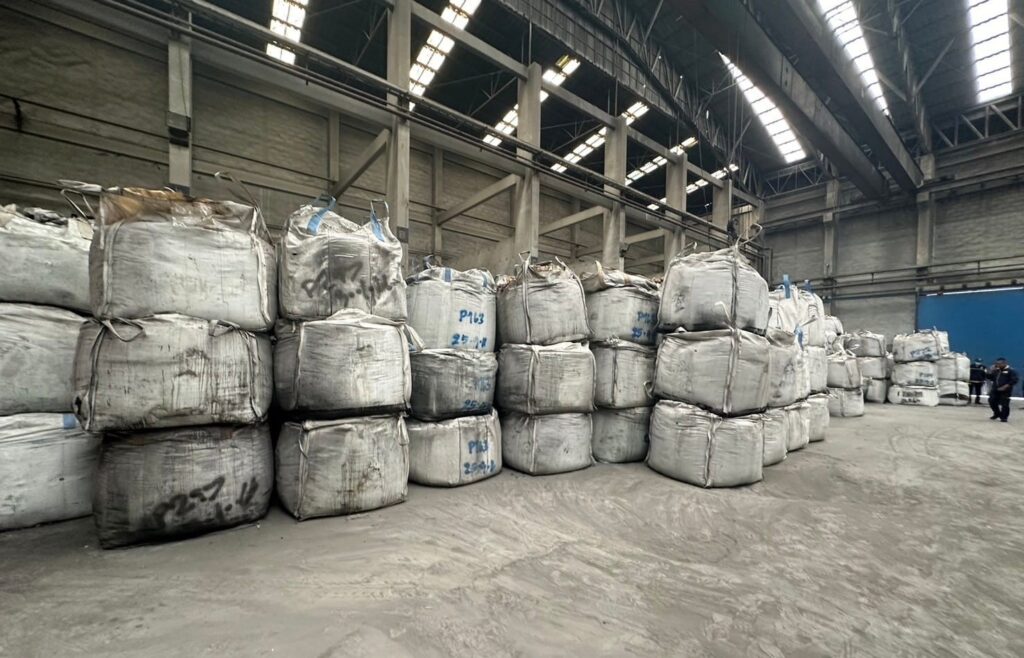The whole hazardous waste management in the country needs a major overhaul alongside disclosure of pollutant release and transfer via enactment of the new Pollutant Release and Transfer Act, they said
EnLAW, which has been campaigning for enactment of the new PRTR act to regular releases and transfers of pollutants in the country more efficiently along with other organisations including EARTH and Greenpeace Thailand, has issued a statement calling for thorough disclosure of information concerning the missing cadmium waste believed to be removed and transferred from landfills in Tak province in the West before being discovered in big bags stored in some recycling plants in Samut Sakhon and Chon Buri provinces in the Upper South and the East late last week.
It’s reported to be 15,000 tonnes, according to Tak Provincial Industrial Office’s record. Nearly 2,500 tonnes were found in a plant in Samut Sakhon and a further 7,000 tonnes of cadmium waste was reported to have been stored in a plant in Chon Buri although it has not yet been confirmed whether it’s from the same source in Tak. Another 1,000 tonnes has been freshly found in another plant in Samut Sakhon, according to concerned officials.
EnLAW said the Industrial Works Department (DIW) supervising the issue has not made public the facts regarding the source of the waste or waste generator, the pollutant transfer by the law, and its destinations. The department has also not yet confirmed whether the pollutant transfer complied with the law and the EIA. As required under the EIA, the waste must be neutralised and disposed of in secured landfills permanently. The environmental advocates are just wondering why they have been removed and transferred out of those secured landfills and whether this action followed the law.
Last but not least, those having violated the law must be investigated and punished to set a standard of practice against any wrongdoers in the future, the organisation demanded, calling for the enactment of the PRTR act to help regulate pollutants in the country.
Sonthi Kotchawat, the country’s former senior pollution assessment official and a member with expertise of the Lower House’s Standing Committee on Industry, who also suggests the government enact the PRTR law, said the latest missing cadmium waste incident reflects the flaws in hazardous waste management of the country.
To transfer hazardous waste, a source of the waste must submit its request with details of the waste and the destinations must endorse and show their capacity to accept the waste for disposal. In this cadmium waste case, the regulators of the department must have been informed of all these necessary facts and conditions attached. So, a permit in this case should not have been granted in the first place and the permit issued is thus deemed to have violated the law.
The prime conditions for this cadmium waste are the facts that it’s hazardous and must be nuetralised and secured in secured landfills permanently without further transfers, and that the recycling plant in Samut Sakhon is reported to be capable of recycling aluminium, not cadmium, which is highly hazardous.
Once the waste is transferred, it will be followed by a GPS device on a vehicle transporting it, which will report back to the regulators to verify the waste at the destinations with the amount first taken out of its source. However, in this case, the regulators are reported of not having acknowledged this reporting until the case broke out last week, from last August when the waste was first transferred out of the landfills.
“This case would not have been made possible and led to the investigation last week if people did not report to the committee. The PRTR act must be enacted immediately to allow the public to engage more in scrutinising our hazardous waste management and such management must be overhauled immediately to boost the public’s trust in the government’s handling of hazardous waste,” suggested Mr. Sonthi.

The hazardous waste
Over 1,200 big bags of around 2,500 tonnes of cadmium waste or tailings neutralised in cement were found in a recycling plant and warehouse in Samut Sakhon province late last week following the revelation of some MPs and the committee, prompting the investigation into its source, which concerned officials so far have managed to link back to some secured landfills in Tak province.
According to the Tak Provincial Industrial Office, which examined the site on April 4, it’s learned that the zinc extraction factory, Bound and Beyond Plc, in Tak province (formerly Padaeng Industry) was no longer operational and its buildings and equipment had been removed already. The office further found that the factory was granted a permit to transfer its waste to be disposed of at a plant in Samut Sakhon province. This was reported to be around 15,000 tonnes.
The office learned there were seven landfills there and two of them were opened up and cadmium tailings stuffed inside them were removed. Some of the waste was already stored in big bags, while the rest was simply piled up inside the abandoned buildings, according to the office.
The Industrial Works Department’s chief, Julapong Taweesri, gave an interview to NBT Connext today, saying that the confirmed amount of the missing cadmium waste is 3,000 tonnes seized in the first plant in Samut Sakhon, and nobody can confirm at this point where the rest of the 10,000 tonnes is. However, based on the documents seized, the officials have tracked the transfer of the waste and learned that some had been transferred to the plant in Chon Buri, where they seized another 4,300 tonnes and arrested the plant’s owner, who is Chinese.
Another fresh seizure of the waste from another plant in Samut Sakhon is around 1,000 tonnes. The amount combined, however, is not equivalent to all that has gone missing and the officials concerned will definitely expand their search, Mr. Julapong stressed, declined to rule out the possibility that it may have been shipped out of the country.
Based on the Pollution Control Department’s examination of potential contamination of the waste in the environment at those plants, there was an extremely high level of cadmium contamination in the waste, measured at 24,884 mg per kg, or almost 250 times compared to the level allowed by the DIW at 100 mg per kg.
Over 2,800 mg per kg of cadmium was also detected in soil both inside and around the plant as well as in front of the factory, three times higher than the level of 810 mg per kg determined by the DIW for hazardous waste contamination in soil within a factory although there was no detection of cadmium in soil within 10 metres to one kilometre in radius around the factory.
There was no cadmium vapour detected in the air, but the level of contamination in water sources nearby is still being investigated. The level of contamination of cadmium in the other plants is still under investigation, according to the PCD. The PCD has suggested not to move back the waste to the landfills in Tak, citing the long distance and long exposure on the way back. Disposal of the waste in Samut Sakhon or nearby provinces could be an option, it suggested.
So far, the Governors of both provinces have prohibited people from entering the compounds without permission. Samut Sakhon Provincial Health Office, meanwhile, has reported that 11 workers at the first factory had cadmium in their bodies beyond the acceptable level, and they are now under treatment. Eight more of them are still under health examination.
Dr. Rungrueng Kitphati, the Department of Science Service’s chief, said his department stands ready to support the officials in the field with information and knowledge on cadmium. If evaporated at a temperature beyond 300 degrees Celcius, cadmium can become a vapour and spoil the air, posing harm to people acutely to the point that their respiratory systems can collapse and fail and cause them death, the noted doctor said.
It can contaminate the environment and enter the food chains, the point that should be watchful, the doctor warned. The world’s renowned case is Itai-Itai disease, under which Japanese people were once sick of chronic exposure to cadmium through the contaminated food chains and developed various disorders including painful renal tubular dysfunction, severe osteomalacia, pseudo fractures, and anaemia, the doctor noted.
As explained by the US’s Department of Labor, cadmium is a soft, malleable, bluish-white metal found in zinc ores, and to a much lesser extent, in the cadmium mineral greenockite. Most of the cadmium produced today is obtained from zinc byproducts and recovered from spent nickel-cadmium batteries, it said.
The metal was first discovered in Germany in 1817 and early used as a pigment because of its ability to produce brilliant yellow, orange, and red colours. It became an important metal in the production of nickel-cadmium (Ni-Cd) rechargeable batteries and as a sacrificial corrosion-protection coating for iron and steel. The common industrial uses for cadmium today are in batteries, alloys, coatings (electroplating), solar cells, plastic stabilizers, and pigments, according to the US’s department.
Cadmium is also used in nuclear reactors where it acts as a neutron absorber. While lithium-ion batteries have made significant gains in popularity for lightweight electronic devices, new market opportunities for industrial applications of Ni-Cd batteries will continue to fuel cadmium use. Increased investment in solar power will also drive cadmium use in the future. China, South Korea, and Japan are the leading producers of cadmium in the world, followed by North America, the department noted.
However, cadmium and its compounds are highly toxic and exposure to this metal is known to cause cancer and targets the body’s cardiovascular, renal, gastrointestinal, neurological, reproductive, and respiratory systems, the department pointed out.
Indie • in-depth online news agency
to “bridge the gap” and “connect the dots” with critical and constructive minds on development and environmental policies in Thailand and the Mekong region; to deliver meaningful messages and create the big picture critical to public understanding and decision-making, thus truly being the public’s critical voice


